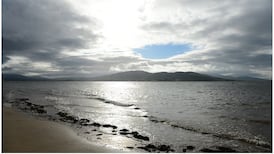A biosecurity alert has been declared after an Asian hornet was captured in Cork city.
The invasive species poses a “significant threat” to Ireland’s biodiversity, the National Parks and Wildlife Service (NPWS) said, adding a single nest of Asian hornets can “devastate” honeybee populations. However, they do not pose a significant public health risk.
The hornet is bigger than a common wasp, and has far less yellow in its body colouring.
The sighting triggered a biosecurity alert, and the NPWS assembled a taskforce of Government departments and bodies to determine whether there is evidence of a larger population. The Asian Hornet Management Group (AHMG) has deployed a number of rangers who are diligently scanning the area for any more individuals and will continue to monitor the situation over the coming weeks.
READ MORE
“Citizen science is going to be key” to prevent the spread of the invasive species, Minister for Biodiversity Christopher O’Sullivan said. “The risk is significant. If a nest is established we can catch it early and destroy it, but if there are multiple nests it’s going to be more difficult.”
A photograph of a sighting by a member of the public was reported to the National Biodiversity Data Centre (NBDC) website on August 7th. Entomologists at the National Museum of Ireland and the NPWS confirmed it was a member of the invasive species.
The confirmation triggered a rapid response protocol, and the survey team was deployed to monitor and survey the area. The team did not initially find evidence of a nest or other hornet activity, but subsequent surveillance led to the trapping of a single Asian hornet on August 12th in the Douglas area of Cork city.
Mr O’Sullivan said the captured hornet has been sent to the National Museum of Ireland to determine whether it is a drone worker or mating queen, the latter of which could indicate a larger population. He said the likelihood the captured hornet was the same as the one sighted on the 7th August is low.
[ Alien species are coming – not all of them in peaceOpens in new window ]
He urged people to be “vigilant”, to do their best to familiarise themselves with what the species looks like and to report any sightings.
This is the second time an individual Asian hornet has been identified in the State. The first one was found dead in Dublin in 2021, and was not associated with a wild viable population.
The species was first identified in Europe in 2004 in Lot-et-Garonne in southwest France. It is believed that the species arrived in a consignment of pottery from China. The Asian hornet has now spread to many regions of France and to several countries in Europe. UK wildlife services are attempting to control the spread of the species there. The European Commission has said the spread of the species is a risk to food production, because of its indirect impact on pollination.
The hornet’s main food source is the honeybee: it hovers at its entrance of a beehive and attacks the bees returning from foraging from below. They also feed on honey reserves and may attempt to enter a hive to predate the brood.
The survey team has been engaging with locals and beekeeping associations to raise awareness about how to identify the Asian hornet.
The NBDC describes the hornet as being between 2.5 and 3 cm long, having dark antennae, a long orange face, an entirely brown or black thorax without stripes and an abdomen that is mostly black except for a yellow band near the tail, with orange lower segments. Its legs are yellow at the ends and it has a small thin stinger that is not normally visible, as it is retractable.
[ Murder hornets: nest of 1,500 destroyed in USOpens in new window ]
Members of the public are being asked to report any suspected sightings through the NBDC’s Alien Watch reporting portal. Any photographs, location co-ordinates, or samples (if safe to collect postmortem) are extremely valuable to the response team.
The NPWS warns people not to disturb or capture an Asian hornet. While not generally aggressive, it may sting if provoked.
The hornet can be easily confused with native species such as the giant woodwasp, the dark giant horsefly and the common wasp.













